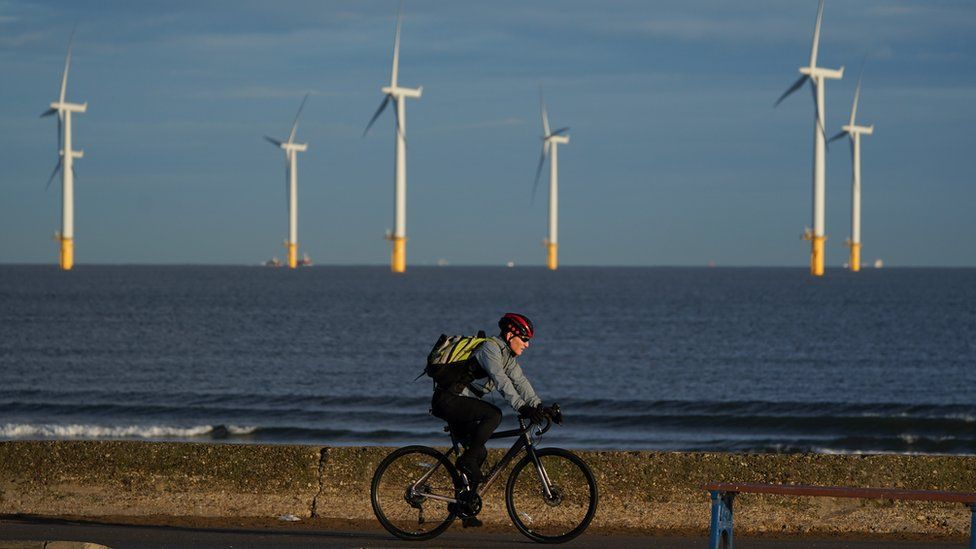Energy: What does the UK's new strategy say?
- Published
- comments

The government has published its long-awaited strategy for increasing the UK's energy independence.
The blueprint aims to move away from Russian oil and gas, and boost renewable energy sources.
Ministers are also under pressure to help tackle soaring energy bills facing consumers, amid rising gas prices.
The document has been delayed amid wrangling over the contents. So what's in it?
Nuclear
The strategy contains an ambition to deliver up to eight new nuclear reactors before 2030, including two at Sizewell in Suffolk.
The government wants nuclear to supply 24 gigawatts (GW) of electricity by 2050 - around 25% of the UK's predicted energy demand.
The UK currently has 15 reactors that can supply about 20% of demand - with most due to cease operating before the end of the decade.
Thirteen new reactors are at various stages of development, but funding and approving new sites has presented major challenges in recent years.
A new government body - called Great British Nuclear - will be set up to oversee the delivery of new nuclear plants.
The government also recently acquired new powers to finance new projects by allowing developers to add costs to customers' bills during construction.
Ministers argue this will prove less expensive for energy customers than current funding models, where these costs can only be added after a station starts generating electricity.
Wind
Offshore wind is also a big part of the plans - with a new target to generate 50GW of energy by 2030.
Ministers hope around a tenth of this could come from turbines based on floating structures, which can be positioned further from the shore.
The government has vowed to relax planning rules to speed up the approvals process from four years to one, and set up a fast-track approvals process for "priority" projects.
A senior source has also told the BBC that Boris Johnson wants to appoint a "Kate-Bingham like" figure to oversee new projects - a reference to the venture capitalist who led a government taskforce on Covid vaccines.
There will be no new target, however, for onshore wind - which has proved unpopular with some Tory activists and MPs.
The government has pledged it will not make "wholesale changes" to planning laws in England for onshore sites, which were tightened in 2015.
Instead, it will consult a "limited number of supportive communities" about hosting new sites, in exchange for guaranteed discounts on energy bills.
Labour has accused the prime minister of "caving" to his backbenchers, and not doing enough to boost new onshore sites.
Oil and Gas
There will be a licensing round this summer for new North Sea oil and gas projects, and a taskforce set up to support new developments.
Ministers say they don't want to burn more gas, but instead produce more of it domestically while they transition to renewables.
Alongside the strategy, a new scientific study has also been commissioned into fracking - the process of extracting shale gas from the ground.
The controversial practice has been subjected to a UK ban since 2019, amid fierce local opposition and fears of earth tremors - but some Tory MPs have been pushing for it to be lifted.
The business secretary says the war in Ukraine means it is right to look at "all possible domestic energy sources".
Kwasi Kwarteng pledged the ban on fracking would remain in place in England unless scientific evidence showed it is safe and causes "minimal disturbance" to nearby residents.
Solar
There's an ambition to increase the UK's current 14GW solar capacity fivefold by 2035.
Planning laws in England will be reviewed to promote the development of new solar farms on non-protected land.
A consultation will also look at how to make it easier to put solar panels on rooftops, including on public buildings.
Supporters of solar say a new generation of farms could provide a source of renewable energy to power hundreds of thousands of homes.
But plans for new farms have faced local resistance, with a number of Conservative MPs also voicing their opposition.
Hydrogen
The strategy contains a target to double UK hydrogen production to 10GW by 2030.
The ambition is that at least half of this will come from electrolytic hydrogen - where electricity is used to split water into hydrogen and oxygen.
This process of producing the gas can be greener than the most common production route used at the moment, by reacting natural gas with steam.
Low-carbon hydrogen production in the UK is still at an early stage, with hopes that advances in technology can reduce costs.
The target to boost production, however, comes with a caveat - it is "subject to affordability and value for money".
Related Topics
- Published12 March 2022
- Published28 March 2022